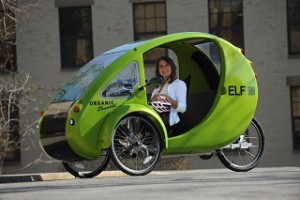New Concept in Low-speed Electric Transportation

The ELF is an electrically assisted bike, meaning that the driver can choose to pedal or not.It comes with a piece of solar PV on its roof, which will charge the battery in between 5 and 7 hours, depending on the sunlight; when plugged into a household electric socket it will reach full charge in about 2 hours. The ELF comes with two different options for the battery, the larger of which provides a range of about 30 miles without pedaling, and as much as 100 miles for those willing to pitch in a few hundred watt-hours. Not only does the driver get some exercise, but he’s also increasing both the range and the speed; when the driver pedals, the vehicle reaches speeds of about 30 miles per hour.
My only gripe with it is that the marketing surrounding it is somewhat deceptive. For instance, the company CEO says that people commonly underestimate the torque that can be generated from cycling with pedals. He goes on to say that two people pedaling are the equivalent of a 6 cylinder turbo. Huh? Why embarrass and discredit yourself with something so obviously wrong?
The vehicle can carry cargo loads of over 500 pounds, making it ideal for local driving and the running of errands–even in the rare case that one is picking up a grand piano or a full-grown hog. There is no mention of the MSRP, but if it’s priced attractively, I can imagine a significant market.

There are a number of variations. Most are essentially a recumbent bicycle with a full body fairing. A proper name for them would be a velomobile and they are often confused with cars. When electrified we could also call them hybrids as they combine human power with an electric motor that most often gets its electricity from a battery but there are some that use solar panels.
The common arrangement is a parallel hybrid but there are a few series hybrids and this is where the connection gets particularly interesting. Here is an article I wrote last year about the Raht racer that goes into some detail about that connection and contains lots of links for further reading. http://www.evworld.com/news.cfm?newsid=34876
The confusion about the torque may be that a gasoline engine is limited with almost no torque at 0 RPM. This is why transmissions are required with petrol power. Steam or electric power have loads of torque starting at 0 RPM.
Prices vary substantially on these vehicles and because of their attractive and unusual nature there is the potential for sponsorship which I also linked in the article.
Also, I believe that the ELF intentionally does not have doors to make it more stable in a cross wind.
That’s possible, but I’m reminded of a conversation I had with a would-be entrepreneur of vehicles like this who proposed to sell them in London. I asked him, “Have you ever been to London? When he told me that he hadn’t, I explained that they get rain 222 out of 365 days there, and they’re not going to be too sanguine about getting wet and muddy.
It’s not as rainy as you think in London, in fact, London is one of the least rainy cities in the United Kingdom. On a 30 year average, there are 106.5 days a year with >1mm of rain.
That said, aerodynamics permitting,some kind of side faring to divert rain around the rider when the vehicle is moving could be useful.
With such a high lightweight vehicle, full doors would be a danger – imagine passing a side road with a gale force cross wind, the vehicle could easily turn over, or be blown into the path of oncoming vehicles.
Is that a fact? I must have been thinking of England as a whole or a certain part. Thanks.